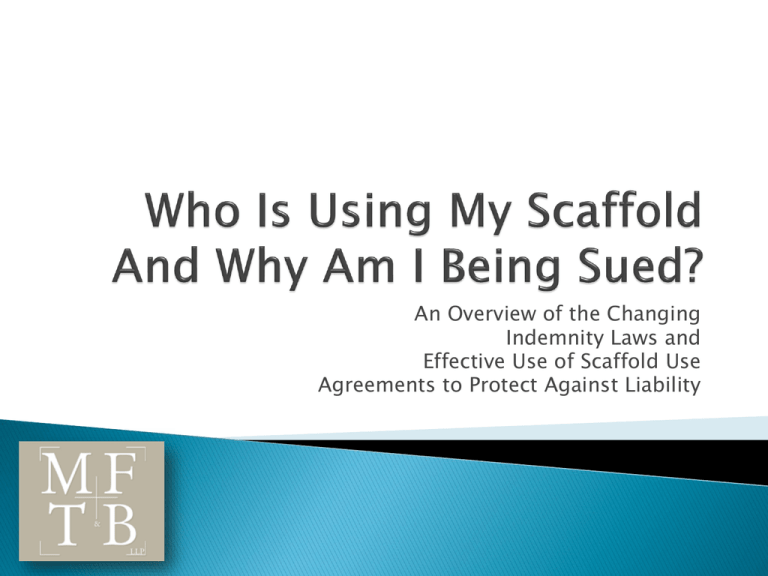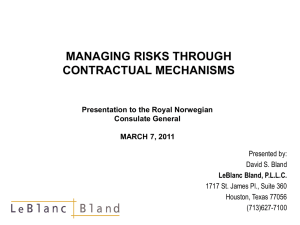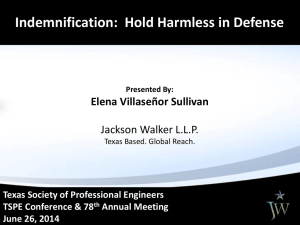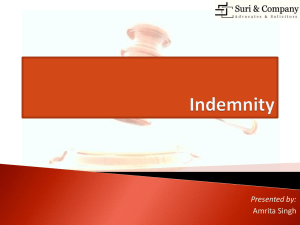Who Is Using My Scaffold And Why Am I Being Sued?
advertisement

An Overview of the Changing Indemnity Laws and Effective Use of Scaffold Use Agreements to Protect Against Liability P. Randolph Finch Jr. Marks, Finch, Thornton & Baird, LLP 4747 Executive Drive, Suite 700 San Diego, California 92121 858-737-3100 www.mftb.com October 12, 2012 An obligation resting on one party (the indemnitor) to make good a loss or damage another party (the indemnitee) has incurred. Equity or “Equitable Indemnity” Apportionment of the loss among joint wrongdoers according to degree of fault based on equitable principles of comparative fault. California Civil Code section 1432 Code of Civil Procedure section 875 Contract or “Express Indemnity” Indemnity based on the express terms of a written agreement. Express Indemnity Provisions Fall Into Three Categories ◦ Type 1 Indemnity ◦ Type 2 Indemnity ◦ Type 3 Indemnity Strongest type of indemnity allowed by law. Provides that the indemnitor is to indemnify the indemnitee “for, among other things, the negligence of the indemnitee.” Only limitation is for liability arising out of “sole negligence” or “willful misconduct” of the indemnitee. Legally enforceable in residential construction subcontracts entered into before January 1, 2009. Legally enforceable in all other construction subcontracts entered into before January 1, 2013. Effective January 1, 2013, an upstream party in a construction contract cannot require indemnity (including defense) from a downstream party for liability caused by the upstream party’s active negligence. (Civil Code sections 2782 and 2782.05.) Expansion of January 1, 2009 anti-indemnity laws for residential construction to all types of construction projects. Under this type of indemnity agreement, the party being indemnified can be indemnified from its own acts of “passive negligence.” However, the party being indemnified cannot be indemnified for its own “active negligence that solely or contributorily causes its liability.” “Active” negligence requires some form of affirmative act (i.e., the creation of a injury causing condition). “Passive” negligence means a failure to perform a duty or affirmative act imposed by law (i.e., the failure to discover or warn against a dangerous condition). In cases involving pre January 1, 2013 projects, this distinction was not a contested issue in most cases as it was nearly impossible to prove a general contractor was more than 99.9% at fault for the loss. However, in claims involving post January 1, 2013 construction contracts, this distinction will be a hotly contested issue by subcontractors and their insurance carriers as most bodily injury and property damage claims and complaints allege active negligence against both upstream and downstream parties to a construction contract. There is no court interpretation of SB 474 and it is likely that disputes on this distinction will be on the rise, increasing claim costs for carriers for both upstream and downstream parties. The increased litigation costs caused by these disputes may have the unintended consequence of increasing insurance costs for both downstream and upstream contractors in terms of higher deductible/SIR payments and/or higher insurance premiums as a result of added claim expenses incurred by collateral indemnity disputes. Without the leverage of a Crawford demand to force subcontractor carriers to settle claims to curb exposure to general contractor’s carrier for costs of defense, there is a built in disincentive for subcontractor carriers to settle claims quickly. This will increase conflicts between contracting parties with ongoing business relationships. Under this type of provision, any negligence on the part of the upstream party, either active or passive, will bar indemnification against the upstream party despite the fact that the downstream party may have been a cause of the upstream party’s liability. To obtain indemnity, the upstream party will have to show sole negligence of the downstream party as the cause of the upstream party’s liability. Example provision: Subcontractor agrees to be responsible for liabilities caused by the subcontractor, but does not agree to be responsible for general contractor’s liabilities caused by other than subcontractor. Does not apply to home improvement contracts with homeowners. Does not apply to wrap-up insurance policies or programs. Does not apply to bar claims for breach of contract or warranty that exist independently of indemnity obligation. Does not apply to indemnity provisions with lenders/financiers/sureties. Does not prohibit contractual requirements that a downstream party insure itself. Does not prohibit contractual requirements for the purchase of specific insurance, including: protective liability, builder’s risk, and “contractors all-risk” insurance. Does not bar claims for Equitable Indemnity. Parties are free to obtain a judicial determination of proportionate share of liability according to degree of fault. SB 474 also prohibits agreements that purport to “insure” against liabilities caused by the active negligence of another. Significant reduction in the effectiveness of additional insured endorsements. Additional insured carriers will have a new basis to deny defense to upstream parties. Incentivizes additional insured carriers to dispute its defense obligations to upstream parties and likely will increase litigation costs associated with coverage disputes. Primary carriers for upstream parties will no longer be able to rely on additional insured carriers to fund its share of the upstream party’s defense. Impact on insurance remains to be seen but expect any cost savings to be offset by increased litigation costs as there is no court interpretation of the effect of SB 474 on an additional insured carrier’s defense obligation. For large scale construction projects and residential developments, expect increased owner/developer forced placement of wrap-up or OCIP type insurance programs on projects to insure against bodily injury and defect claims. Ensure the subcontract indemnity and insurance procurement provisions comply with SB 474. Reject provisions in subcontract agreements which require broader indemnity and insurance than allowed by SB 474. No type 1 indemnity provisions. Participate in OCIP or WRAP programs. These types of programs provide insurance for the entire project team and avoid the added costs associated with indemnity and insurance coverage disputes as all tiers are covered by the same policy. Have the OCIP or WRAP program reviewed by your insurance broker or attorney. No single program is the same and they will have varying levels of SIR deductibles. Typical subcontracts require a minimum SIR contribution equal to the subcontractor’s deductible or a stated amount. Because SB 474 benefits subcontractors and their carriers, negotiate for lower insurance premiums which may translate into reduced insurance costs and more competitive bids/pricing. Scaffolding and staging equipment is a major safety concern on projects. Heavily regulated by CAL OSHA. The following slides are resources you should be familiar with. This pocket guide includes all CAL OSHA regulations related to scaffolding. Full publication available at www.dir.ca.gov/dosh/ If you furnish scaffolding for your project, CAL OSHA will pursue you for fines even if an incident occurs during third party use. CAL OSHA will view you as responsible because of your perceived ownership and control. So, to the extent practicable, always monitor the use of your scaffolding! Your person in charge of the site should inspect the scaffolding at the beginning and end of each work day. Any alterations on the scaffolding must be redtagged and all future use of the scaffolding must be halted until the alterations are fixed. But what do we do when other trades use our scaffolding with or without our knowledge? If an employee of another trade contractor is injured using your scaffolding, his only remedy against his employer is worker’s compensation, but he also has the ability to pursue a direct claim against your company for his injuries. To avoid this potential liability, you must be proactive prior to the injury. Labor Code section 3864 provides: “If an action as provided in this chapter prosecuted by the employee, the employer, or both jointly against the third person results in judgment against such third person, or settlement by such third person, the employer shall have no liability to reimburse or hold such third person harmless on such judgment or settlement in absence of a written agreement so to do executed prior to the injury.” Courts have ruled that this statute requires both the indemnitee (you) and indemnitor (other contractor) to sign the written indemnity agreement prior to the injury. If you only have the other contractor sign, it will be ruled unenforceable! (Hansen Mechanical, Inc. v. Superior Court (1995) 47 Cal.App.2d 47.) So, to avoid liability to a third party’s employee due to their use of your scaffolding, you must execute an indemnity agreement with the third party prior to the injury. Present a separate Use of Equipment Agreement to each trade on a project that may use your scaffolding; or Seek to shift the risk to general contractors for use of your scaffolding by others within their control, and then have the general contractors shift the risk to the other trades through their subcontracts in favor of both the general contractors and you. Example on following slides.











